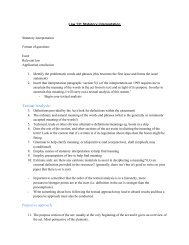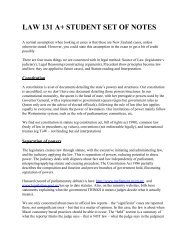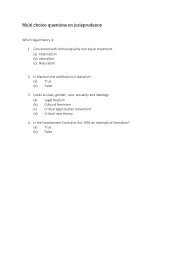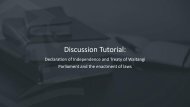Create successful ePaper yourself
Turn your PDF publications into a flip-book with our unique Google optimized e-Paper software.
LAW131 WEEK 5
Background Concept – Absolute Liability<br />
RYLANDS V FLETCHER<br />
What you should know for the test:<br />
• fault or whether someone intended to<br />
commit the act is irrelevant<br />
• often attached to activities which are<br />
inherently dangerous and have no social utility<br />
• rationale: if someone is engaging in a risky<br />
activity, they should pay damages for any harm<br />
that arises as a result<br />
• Material facts<br />
• Issue<br />
• Ratio/Key Principles<br />
• Elements
RYLANDS V FLETCHER<br />
Summary<br />
• A reservoir was built on the defendant’s land, and without their fault, the water escaped through old mine shafts and<br />
flooded the plaintiff’s new coal mine<br />
• The House of Lords held that if the water had escaped naturally and with no action on the part of the defendant, then<br />
no action would lie<br />
• However, in this case the water was brought onto the land, stored, and used in a non-natural way. Therefore, the risk is<br />
on the defendant and they were found liable<br />
Key Principle<br />
When the defendant brings or collects on land something likely to do mischief it it escapes and the use of the land is<br />
non-natural then the defendant is liable for damage which is the natural consequence of the escape of that thing.
RYLANDS V FLETCHER<br />
Elements<br />
• brings or collects on the land<br />
• non-natural use of the land<br />
• for own purposes<br />
• escape to an area outside control (Read v Lyons: escape from a place where the defendant has occupation or<br />
control over land to a place which is outside his occupation or control)<br />
• likely to cause mischief (foreseeability) (Cambridge Water: one could only be strictly liable for damage which<br />
is deemed reasonably foreseeable.) This is an objective test.<br />
• There is likely going to be some contentious and some non-contentious elements. Identify which are noncontentious<br />
and state (listing the elements) that they are non-contentious/made up on the facts. Then, move<br />
onto the contentious elements<br />
• Give both sides of the argument for the non-contentious elements and suggest which side is stronger
RYLANDS V FLETCHER<br />
Even if all elements are fulfilled, your client/the defendant may have a defence available to them.<br />
• The plaintiff did something which caused the damage<br />
• The defendant had taken all reasonable care<br />
• It escaped naturally as a result of a third party and with no action on the part of the defendant<br />
• Act of God<br />
Nichols v Marsland – rainfall was sudden and unexpected, and the volume/extent of rain had not happened before<br />
Potential ways to distinguish<br />
• If the mischief/harm occurs on the defendant’s property, meaning that it does not escape to a neighbouring<br />
property<br />
• If it is a natural use of land – look at time, place and common practice. For example, if there is a munitions<br />
factory in an industrial community during the war time, this is less likely to be found as a non-natural use of<br />
land. Read v Lyons
IN THE TEST<br />
Material Facts<br />
• look out for facts that prove or disprove elements (bringing or collecting anything on land this is likely to cause mischief, non-natural use of land) that need to be fulfilled<br />
in order to find your client liable. This is because these are the facts that if changed, will change the outcome. You are likely to be given a fact scenario that is very similar to<br />
one of the main cases you have studied in class (though they may change some material facts).<br />
Issue<br />
• ’Whether … when’ structure<br />
• Use this to incorporate significant material facts<br />
• Identify the umbrella/broad issue first, then identify sub-issues. You will need to follow the IRAC structure for each sub-issue.<br />
Relevant Law/Rule<br />
• Identify relevant authorities and state why/how they are relevant – it is not enough to just state that the case might be relevant<br />
Application<br />
• Develop reasoned arguments, and make sure that you have a strong logic chain<br />
• reasoning by analogy<br />
• deductive reasoning (E.g. rule, your situation, conclusion)<br />
• if an additional material fact would significantly change the outcome, state what the fact is and how it would impact the outcome<br />
• Consider both sides of the argument for contentious points<br />
Conclusion
DONOGHUE V STEVENSON<br />
Summary<br />
• A friend buys ginger beer from a shopkeeper<br />
• A partially decomposed snail is poured out<br />
after some of it has been drunk<br />
• The plaintiff suffered bodily injury and shock<br />
• The glass was opaque
Issue – Lord Aitken<br />
The question is whether the manufacturer of an article of drink sold by him to a distributor, in circumstances which<br />
prevent the distributor or the ultimate purchaser or consumer from discovering by inspection any defect, is under any<br />
legal duty to the ultimate purchaser or consumer to take reasonable care that the article is free from defect likely to<br />
cause injury to health.<br />
Key Concepts<br />
• Corrective Justice – the idea that liability must be bound by fault. This needs to be balanced with pragmatic need<br />
to develop laws which limit the range of complainants and the extent of their remedy.<br />
• Neighbour Principle – this involves taking reasonable steps to avoid acts or omissions which one could<br />
reasonably believe would lead to injury (duty of care arises). This has an objective standard.<br />
• We now also associate the concept of proximity with this. Lord Atkin acknowledges that this is not just physical proximity.<br />
• Modern Test – Whether the intermediate examination afforded the Plaintiff adequate protection against the<br />
damage?<br />
Important Reasoning<br />
• As the bottle was opaque, the purchaser could not see the contents. Hence, the defence of intermediate<br />
examination does not apply in this case. In contrast, in cases concerning leaky homes, the defence may apply as the<br />
purchaser can examine the home beforehand.
PROVING NEGLIGENCE<br />
• Duty of Care<br />
- This is important because it limits the ambit of the tort to perceived reasonable bounds to prevent limitless liability<br />
- Richmond P: A builder is not liable to a purchaser with actual knowledge of the defect or if they are in a circumstance where they could have used<br />
the opportunity of inspection in a way that would have alerted them to the defect<br />
- Woodhouse J reflects a similar idea: Not liable to a purchaser who has knowledge or could reasonably obtain knowledge through inspection<br />
• Breach<br />
- Whether the plaintiff has departed from the standard of a reasonable person<br />
- Focus on the quality of the defendant’s conduct and whether it is blameworthy<br />
- Objective standard but reasonable person in their circumstances<br />
• Cause<br />
- Whether the plaintiff’s conduct has caused the defendant loss<br />
- Focus on the causal link between the breach and loss. It may be helpful to use the ‘but for’ test<br />
- Cooke J: Buyers are not expected to check building plans – they rely entirely on the builder<br />
• Remoteness<br />
- Focus on the type of harm and whether it is a sufficiently proximate consequence
POLICY CONSIDERATIONS<br />
Reasons suggesting that there may NOT be a duty<br />
• Floodgates<br />
• Economic loss<br />
• Negligent Misstatements<br />
• Alternative Remedy<br />
• Commercial Certainty<br />
• Liability should be proportional to fault<br />
• Interference with other areas of law<br />
Reasons suggesting that there SHOULD be a duty<br />
• Compensation<br />
•Vulnerable plaintiff<br />
• Improving professional standards
MARKING GUIDE – HIGHER GRADES<br />
• Focus on key issues – identify and word them accurately. Ensure that you pick contentious ones!<br />
• Convincing conclusion – explain why one side is more persuasive than the other and ensure that you have<br />
a strong logic chain<br />
• Needs to be succinct and have clarity<br />
• Use a full range of legal arguments: learn the 8 ways of distinguishing and the material facts and issues of<br />
case law you have been given really well<br />
• Integrate awareness of whether a decision is binding or not













